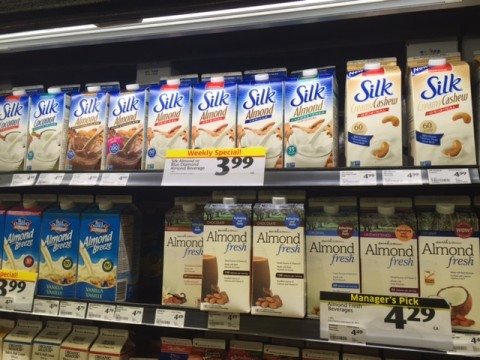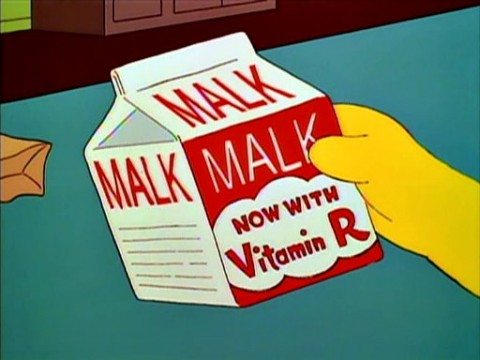
“Milk” at my local grocery store
I knew milk alternatives were becoming mainstream when a new bakery/café appeared in my neighborhood. I ordered a latte and learned that they didn’t use milk. At all. Not only were the baked goods vegan, organic, “natural” and some were gluten-free, they were completely dairy-free for their coffee beverages. While everything looked and smelled great, I was shocked that they had no milk on the premises. The milk alternative made with soy didn’t taste bad, but it didn’t taste like milk. I left with my coffee, wondering how long the place would survive. I was wrong. It’s been a few years and the shop is still here, suggesting there’s a sizable appetite (at least in my laid-back, coffee-shop-saturated neighborhood) for milk-free, wheat-free vegan food and drinks. I shouldn’t be surprised. The number of people on restricted diets seems to be growing, and so have the food choices to meet their dietary demands. There have always been people that avoided milk, but the reason was traditionally lactose intolerance or dairy allergies. Now more are simply choosing to avoid it. I’m often asked about the merits of milk and the multiple milk alternatives, as the assessments of dairy seems to take one of two positions: Either milk is the dietary equivalent of unicorn tears, a nearly perfect food, or it is poison that’s almost certainly killing us. What’s clear is that we have more choice than ever for milk-like beverages. My local grocery is pictured above, where cow’s milk is just one small section. Who knew you could milk cashews?
I can understand and appreciate why people might not drink milk, for cultural reasons alone. I grew up drinking milk and eating dairy products regularly, but married into a family that didn’t drink or eat any at all. When my kids were young, we went through a lot of milk each week. Now that they’re older, our consumption’s dropped, as they almost always opt for eggs instead of cereal each morning. Given juice is tightly restricted in my home, milk’s now mainly for coffee, cooking, and helping the kids meet their vitamin D requirements. Whether it’s society’s declining devotion to breakfast cereal, concerns about animal welfare, or recognition that consuming milk simply isn’t essential, habits have changed. In North America consumption is dropping steadily over time, something the dairy industry seems unable to reverse. With the decline of milk, there has been a rise in the number and types of milk-like beverages, raising the question of the relative merits.
Whether milk is “good” or “bad” and how it compares to the alternative “milks” depends on the question being asked. Good for what? Chemically, milk is emulsified fat in water that’s a good source of protein and several nutrients. If studying the effects of medication is difficult, that’s nothing compared to studying dietary interventions, where it’s exceptionally challenging to tease out cause and effect from studies which lack randomization and blinding. Correlation is not causation, and addressing all of the potential confounders seems nearly impossible. The result is trials with often equivocal results that are used to support nearly any position. Milk may be a good source of calcium, but consumption doesn’t seem related to fewer hip fractures as we age. It’s cited as an important part of the DASH diet, but DASH didn’t look at dairy in isolation. Cancer is often attributed to milk, but there’s a lack of convincing data. Even autism has been blamed on milk, a claim that’s never been substantiated. On balance, from a strictly nutritional perspective, milk is probably neither good nor evil, especially when you consider it’s just one component of a diet. When consumed in moderation, there are almost certainly other factors, many controllable, that can have more significant effects on overall health (e.g., regular exercise, not smoking, and maintaining a healthy weight).
The alternatives to regular milk seem to have grown in popularity for different reasons. Organic milk caters to dietary preferences, but there’s no convincing evidence organic food is healthier. Lactose-free milk makes milk tolerable to those that lack the ability to digest the sugar lactose. Raw milk (where it’s legally sold) seems to exist for those that prioritize taste over the risk of a food-borne illness. Others are concerned about what else might be in milk. Just yesterday there was a report that milk may not always be free of antibiotic residues. Nobody wants (or should accept) ciprofloxacin in their milk, especially when any detectable amount is forbidden.

Oh, my bones are so brittle. But I always drink plenty of…”malk”?
There are more and more “milks” on the market. The most common ones are soy and almond, but you can also find rice, oat, coconut, potato, and even hemp milks for sale. Each has its own nutritional profile. Many are fortified (to mimic milk’s content) and often contain added sugars and flavors, so the nutritional profiles vary widely. (This CSPI table is among the more comprehensive). It’s important to note that plant-based milks lack the nutritional and caloric density of real milk, and are not a safe substitute in young children (<2 year). While there are nutritional differences between the products, eating an otherwise-balanced diet with plenty of variety is probably the best approach to minimize the risk of dietary gaps. Total calories is one area where these products can vary significantly, and given liquid calories don’t seem to satiate like food, it is reasonable to conclude that consuming in moderation is best.
Almond milk is one of more popular “milks” now. It’s made by soaking ground-up almonds in water and then removing the solid matter. Almond milk leverages the health halo that almonds currently enjoy, offering “good fats” and vitamins. Nutritionally, almond milk has a fraction of the protein of milk. One cup of almond milk contains the protein equivalent of just four almonds. Almonds, not almond milk, are a much more convenient and nutritionally-dense source of energy. The rest is expensive water, often fortified with vitamins and sometimes added sugar.
Soy milk was one of the earliest milk substitutes. Soy comes closest to real milk from a nutritional perspective, and some are fortified with vitamins to closely mimic real milk. Soy contains alpha-linolenic acid (ALA), an omega-3 fatty acid too, but if you’re not a vegan, you’d be better off eating other omega-3 sources. The relationship between soy and cancer is unclear.
Coconut milk is a mix of coconut water and the thick coconut cream. Like other coconut products, there’s a fair amount of saturated fat. They’re low in protein, and usually fortified with vitamins.
Rice milk is low in protein but usually has levels of calcium that approach real milk. There are some concerns about arsenic levels, but the overall health impact isn’t clear. Compared to the other milks, rice tends to come up short from a nutritional perspective.
Conclusion
If you enjoy drinking milk, there’s no convincing evidence to suggest you’re doing your body badly. If you’re consuming milk strictly for the perceived health benefits, then it’s fine to omit it from your diet. Milk isn’t magical and it isn’t poison. The same applies to the milk substitutes. If you want a milk-like beverage to drink, then there are lots of choices, and you can probably find one that you find palatable and is also fortified to deliver many of the nutritional benefits of regular milk.
